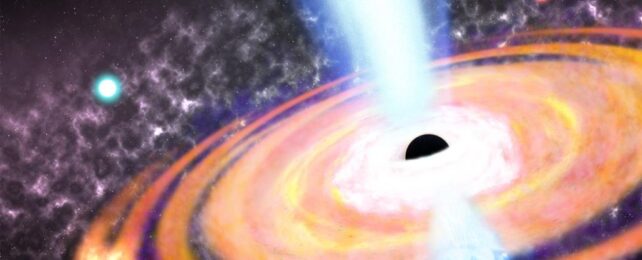The beginning of the Universe has always been something of a chicken-and-egg problem. Did stars and galaxies form first, with black holes slowly coalescing in their midst? Or did black holes appear before the first galaxies?
As matter started to cool and coalesce following the Big Bang, it arranged itself into the shapes and objects we observe throughout most of its 13.8 billion-year history. Today we see those objects as stars arrayed in gravitationally bound systems we call galaxies, which revolve around a supermassive black hole in their center.
Traditionally, it has been assumed that the stars and galaxies were here first. But a new analysis of data from the early Universe collected by the James Webb Space Telescope suggests that actually, the black holes and galaxies emerged together – and that the black holes shaped the galaxies that evolved around them.
"We know these monster black holes exist at the center of galaxies near our Milky Way, but the big surprise now is that they were present at the beginning of the Universe as well and were almost like building blocks or seeds for early galaxies," says astronomer Joseph Silk of Johns Hopkins University in the US and Sorbonne University in France.
"They really boosted everything, like gigantic amplifiers of star formation, which is a whole turnaround of what we thought possible before – so much so that this could completely shake up our understanding of how galaxies form."
There's a lot we don't know about the early Universe, for the simple reason that we can't see it. When matter first started coming together during the first 500 million to 1 billion years after the Big Bang, a thick haze of gases between stars and galaxies made space opaque.
We thought we had a fairly decent handle on things. But then, in the last decade or so, we started to find things that were inconsistent with the model scientists had built. Like black holes and galaxies that were far bigger than we thought could have formed in the time since the Big Bang. And when the JWST came along, it showed there were significantly more of these big things, spotted even earlier, than we had imagined.
Supermassive black holes present a particular problem, because of the way some black holes form from stars. When a particularly large star dies, its core collapses, and what remains is a black hole up to around 50 times the mass of the Sun.
Bigger black holes can form from collisions between these objects… but supermassive black holes are millions to billions of times the mass of the Sun. If these objects are forming from the ground up, it would take a very long time indeed, and stars would have needed to be around first.
JWST data reveals that there were supermassive black holes very early in the Universe's history. We've spotted behemoths less than 500 million years after the Big Bang, one at 470 million years, the other at 400 million; and, interestingly, the mass of the latter black hole, around 1.6 million Suns, appears to be equal to the masses of the baby galaxies swirling around it.
This strongly implies another mechanism for black hole formation: huge clouds of matter collapsing directly into black holes without becoming stars in the first place.
According to the analysis conducted by Silk and his team, this means they could have been present from very early on, coexisting with the baby galaxy and spurring on its growth. As the central part of the cloud collapsed into a black hole, the remaining outskirts of the cloud became the material for forming baby stars.
This is because the black hole feeding process whips up powerful winds and jets of high-speed plasma that tear through the surrounding space, compressing the star-forming gas therein and triggering intense waves of star formation.
"We're arguing that black hole outflows crushed gas clouds, turning them into stars and greatly accelerating the rate of star formation," Silk says.
"We can't quite see these violent winds or jets far, far away, but we know they must be present because we see many black holes early on in the Universe."
Future observations should help astronomers work out the accuracy of this model, and further refine it.
But for now, it is starting to seem that the chicken-or-egg problem is an oversimplification: it's not one or the other, but both, together, transforming the soup of the early Universe into the glorious population of galaxies, each powered by a black hole, that dazzle across the cosmos as far as we can see.
The research has been published in The Astrophysical Journal Letters.
